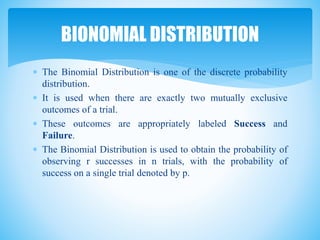bionomial distribution
- 1. QUANTTATIVE TECHNIQUES SUBMITTED BY: RITU NEMA PRAJIT MOHANAN PRASHANT VERMA Presentation on BIONOMIAL PROBABLITY DISTRIBUTION
- 2. ïŠ A random experiment with only two outcomes is a result of Bernoulli's experiment. ïŠ One outcome is labeled âpâ (success), other is âqâ (failure). ïŠ P= p(success)+q(failure) ïŠ Example: If we consider heads as success, then tails will definitely be a failure. ïŠ A binomial distribution arises when Bernoulliâs experiment is performed ânâ number of times. Bernoulli Experiment
- 3. ïŠ The Binomial Distribution is one of the discrete probability distribution. ïŠ It is used when there are exactly two mutually exclusive outcomes of a trial. ïŠ These outcomes are appropriately labeled Success and Failure. ïŠ The Binomial Distribution is used to obtain the probability of observing r successes in n trials, with the probability of success on a single trial denoted by p. BIONOMIAL DISTRIBUTION
- 4. ïŠ The experiment consists of a sequence of n identical trials. ïŠ Each outcome must be classified as a success (p) or a failure (q). ïŠ The probability distribution is discrete. ïŠ Each trial is independent and therefore the probability of success and the probability of failure is the same for each trial. CHARACTERSTICS
- 5. FORMULA
- 6. ïŠ If a student randomly guesses at five multiple-choice questions, find the probability that the student gets exactly three correct. Each question has five possible choices. Example 1
- 7. SOLOUTION ïŠ In this case n = 5, X = 3, and p = 1/5, since there is one chance in five of guessing a correct answer. Then,
- 8. A (blindfolded) marksman finds that on the average he hits the target 4 times out of 5. If he fires 4 shots, what is the probability of.. (a) more than 2 hits? (b) at least 3 misses? EXAMPLE 2
- 9. SOLUTION









